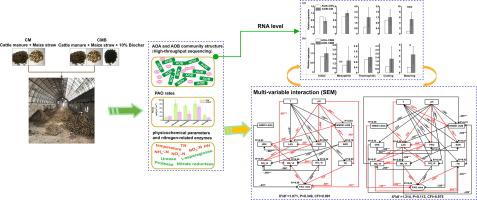Bioresource Technology ( IF 9.7 ) Pub Date : 2020-12-28 , DOI: 10.1016/j.biortech.2020.124572 Liting Deng , Yan Zhao , Jizhou Zhang , Ayodeji Bello , Yu Sun , Yue Han , Bo Wang , Ugochi Uzoamaka Egbeagu , Detian Li , Chol Jong , Xiuhong Xu

|
This study investigated nitrification process during cattle manure-maize straw (CM) and biochar (CMB) composting in terms of multi-variable interaction (MVI) among environmental parameters, ammonia-oxidizing archaea (AOA) and bacteria (AOB) community structure, nitrogen-related enzymes as well as substrates using structural equation model (SEM). Results showed that adding biochar significantly reduced potential ammonia oxidation rates. SEM analysis revealed that AOB was affected by temperature and pH, which stimulated the release of urease, increased NH4+-N concentration and finally exerted influence on nitrification in CM. Temperature (0.755) and NO2−-N (-0.994) were identified as the main factors mediating nitrification in CM and CMB, respectively. Moreover, MVI analysis indicated that nitrification and denitrification occurred simultaneously. Mutual verification of SEM and quantitative analyses (RNA level) confirmed that AOB predominated nitrification. The above results indicated that nitrification could be better explained by MVI using SEM during composting.
中文翻译:

从多变量相互作用的角度了解牛粪-玉米秸秆和生物炭堆肥过程中的硝化作用
这项研究从环境参数,氨氧化古细菌(AOA)和细菌(AOB)群落结构,氮的多变量相互作用(MVI)的角度研究了牛粪-玉米秸秆(CM)和生物炭(CMB)堆肥过程中的硝化过程。相关的酶以及使用结构方程模型(SEM)的底物。结果表明,添加生物炭可显着降低潜在的氨氧化速率。SEM分析表明,AOB受温度和pH的影响,刺激脲酶的释放,增加NH 4 + -N的浓度,最终影响CM的硝化作用。温度(0.755)和NO 2 --N(-0.994)被分别确定为介导CM和CMB硝化的主要因素。而且,MVI分析表明硝化和反硝化同时发生。SEM的相互验证和定量分析(RNA水平)证实了AOB在硝化作用中占主导地位。以上结果表明,在堆肥过程中使用SEM可以通过MVI更好地解释硝化作用。

































 京公网安备 11010802027423号
京公网安备 11010802027423号